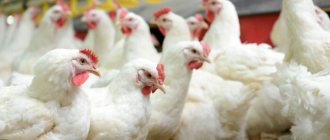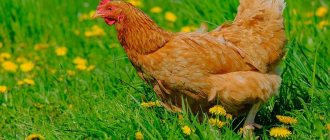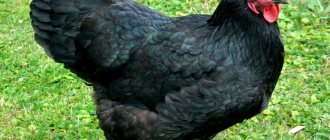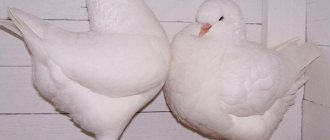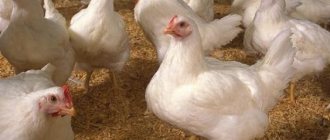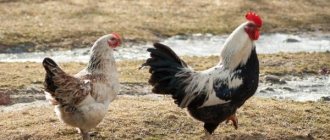When planning to start a business selling large quantities of chicken meat, you need to calculate in advance how much a chicken of a particular breed or variety weighs. This will help determine the number of chickens, feed and the approximate timing of receiving goods for sale. In the article you will find information about the weight of broilers and laying hens. You will learn how and when to weigh birds while raising them.
Why do you need to control your weight?
The body weight of chickens must be constantly monitored. This will avoid unnecessary expenses on the purchase of feed and additives. Why overfeed a bird that has already reached its weight limit.
It will be possible to stop adding nutritious feed in a timely manner. Before chickens develop obesity.
By monitoring your weight, you will be able to identify those from the herd who are not receiving enough nutritional supplements. After all, underfed chickens develop rickets, gout and other diseases.
By controlling the growth of chickens, you can simultaneously monitor their health. Sick birds refuse to eat and quickly lose weight. Knowing how much a broiler or purebred chicken should weigh at a certain age, you can promptly identify those who are sick.
About egg production
Most breeds of laying hens often lay large eggs, the shells of which can be white or brown, depending on the color of the bird's plumage. At first, pullet hens lay small eggs, but as they grow older, the eggs become larger - the oviduct lengthens and widens. The demand for representatives of egg breeds in households and on an industrial scale is explained by the fact that they mature early and quickly gain weight.
The weight of a laying hen does not affect her egg production. Birds with a small body weight can produce a large number of eggs on a par with their larger relatives.
Each hen produces approximately 250-300 eggs during the year, and she continues to lay eggs for 9-10 months of the year. The size of eggs is influenced by the quality of the conditions in which the poultry is kept and a well-formulated diet. It is also worth paying attention to the characteristics of the breed; the weight of eggs in chickens of different breeds varies from 45 to 100 g.
How to correctly determine mass
To find out how much a broiler or purebred chicken weighs, use electronic scales, a steelyard, a regular bag or a cardboard box. Start by determining the tare weight. It will need to be subtracted from the total indicator on the scales.
A small chick can be weighed in a gauze bag with a tight bottom and handles. To weigh adult broilers, bags and burlap sacks are used.
To prevent the bird from twitching and creating disturbances, two holes are made in the bottom of the bag. The chicken's legs are inserted into them and fixed in a standing position, holding it by the body through the bag.
If the bird is restless and it is not possible to weigh it in a bag, use a cardboard box. Calmly behaved chickens are simply placed on scales and weighed.
How to determine the weight of a broiler?
A broiler chicken is born with an average weight of 40-44 g. It begins to grow quickly. At 1 month, its size and weight increase 50 times. To monitor the normal development of young animals and the efficiency of feed consumption, certain measurements are necessary. The chickens are weighed. Electronic scales are used for this.
If the livestock is large, then the weight of 50 heads is determined individually. If there are 150 chickens in the house, then the resulting indicator is multiplied by 3. In this way, the total weight of the poultry flock is obtained. An error of 10% is taken into account. This is necessary because most often there are both cockerels and hens in the same flock. They develop differently. The weight of hens is 500 g less than that of cockerels: they gain weight more slowly.
Weighing chickens is necessary during the sale of meat products. The meat yield of broilers is 80%. The expected result is calculated in order to take into account meat productivity. Additionally, the cut carcass is weighed. When weighing, use the box in which the chicken is placed.
Determining how much a chicken weighs is necessary not only when selling meat, but also to determine the development and growth of young animals. There are tables that show weight by day and by decade. At the same time, it is indicated how much feed the chicken needs to consume, what daily weight gain should be expected.
More on the topic: How many days does a hen hatch eggs before chickling?
The following indicators are typical for broilers:
- 1 decade – 256 g; the chicken requires 40 g of feed;
- 2nd decade – 778 g; feed required 106 g;
- 3rd decade – 1581 g; chicken eat 130 g;
- 45 days – 2 kg; 150 g feed required.
Raising chickens longer is not recommended. Muscle mass will grow, the poultry farmer will make a good profit, but the bird will begin to have problems with the skeleton. Bones will not be able to support large muscle mass. Selectors developed the broiler breed in order to obtain a large yield of meat from the birds in a short period of time.
Little attention was paid to immunity and skeletal structure, so broilers are given vitamin cocktails and antibiotics from birth. This will support the skeletal system and will be a good prevention against infectious diseases.
If the weight of a chicken deviates from the norm towards a decrease, this may mean that the flock is not receiving enough food or there is a large crowd of birds on the site: not all individuals can eat normally.
Deviation from the norm in the direction of increasing weight is also not a good sign. Chicks may become obese, which reduces the quality of meat. Its juiciness will be achieved not by the special structure of muscle fibers, but by the fat layer.
Igor Nikolaev
auto RU
To ensure that the weight of all birds in the herd is approximately the same, attention is paid to the uniformity of the flock. Active individuals, which are gaining weight well, and sedentary chicks, whose live weight is reduced, are divided into different herds. Be sure to observe crowding: there should not be more than 3-4 chickens per 1 m2 if they are 30 days old.
What does weight depend on?
Variety: Given the same amount of feed, broilers weigh more than purebred chickens. This is due to the genetic characteristics of their body.
Productive focus: chickens are raised for eggs and meat. Representatives of any breed can cope with this task.
But the quality of the resulting product and its quantity also depend on the productive orientation or propensity of the chicken to produce and accumulate the product. Thus, the average weight of broilers is 3-4 kg, and egg-laying chickens are 1-2 kg.
Nutritional value of feed: if a bird does not receive all the nutrients necessary for its growth, then its weight will be less.
The weight of a chicken also depends on its age. So, day-old chicks weigh very little. But with proper care and feeding, they grow quickly and gain size.
Weight of chickens of popular egg breeds
Purebred purebred laying hens develop at a predictable pace, subject to feeding technology and the absence of health problems. All representatives of the category of egg-laying chickens have similar body weight parameters and approximately the same development rates. But for keeping purebred laying hens, it is important to know the age limits of the norm in order to respond to deviations in a timely manner.
The tables below indicate the normal limits. A slight deviation in weight gain in laying hens is not a cause for concern. If the gap is larger, we may be talking about the development of obesity - you need to reduce the consumption of fatty and carbohydrate foods and switch to low-calorie feed.
Leghorn
The famous Italian breed of egg-laying chickens is the leader in popularity. Leghorn productivity is 200 eggs per year, the weight of each egg is from 55 to 58 grams. Maximum rates are observed within 1.5 years from the start of laying. Leghorns have become the basis for most egg hybrids and crosses, popular in industrial and domestic poultry farming.
| Age | Chicken weight in grams | Rooster weight in grams |
| 10 days | 72 | 78 |
| 20 days | 180 | 200 |
| 30 days | 260 | 280 |
| 50 days | 560 | 600 |
| 2 months | 750 | 800 |
| 2.5 months | 920 | 990 |
| 3 months | 1300 | 1400 |
| 1 year | 2000 | 2600 |
Russian white
The breed was approved in 1953, and classifiers immediately classified it as an egg breed. As the name suggests, there is only one color, white. The annual productivity of the Russian white laying hen is 200-230 eggs. The breed has become popular in the Russian Federation due to its pronounced frost resistance and high survival rate. The laying hen grows and develops relatively quickly, and is unpretentious in feeding and care.
| Age | Chicken weight | Rooster weight |
| 10 days | 55 | 60 |
| 20 days | 100 | 110 |
| 30 days | 210 | 230 |
| 50 days | 440 | 490 |
| 2 months | 480 | 540 |
| 2.5 months | 680 | 750 |
| 3 months | 750 | 820 |
| 1 year | 1700 | 2000 |
Araucana
Classifiers classify the breed into two categories simultaneously. Egg-laying chickens by type of productivity, decorative chickens by appearance. Representatives of the breed are distinguished by lush sideburns and a beard. Araucana is a productive layer native to Chile. During the year, she supplies the poultry farmer with from 180 to 220 eggs, the weight of which is traditionally in the range of 55-60 grams. But there is a peculiarity - the eggshell has an unusual turquoise color.
| Age | Chicken weight | Rooster weight |
| 10 days | 50 | 55 |
| 20 days | 90 | 110 |
| 30 days | 210 | 230 |
| 50 days | 460 | 510 |
| 2 months | 800 | 900 |
| 2.5 months | 950 | 1100 |
| 3 months | 1100 | 1300 |
| 1 year | 1500 | 1800 |
A time-tested breed of egg-laying chickens
Leghorn
Descendants of Leghorns, achievement of domestic selection
Russian white
A tailless breed of chicken that lays turquoise eggs
Araucana
Causes of failure to gain weight
Quality of feed and quantity of feeding: in winter, birds are fed three times a day. In summer, the number of feedings is reduced to 2 times. The low calorie content in feed has a significant impact on the weight of a broiler or purebred chicken. Food should be supplied to the feeders on schedule.
Improper growing conditions: Birds should not be kept in cramped, poorly ventilated areas with insufficient light. A large walking area also has a negative impact on weight gain.
Molting: Chickens may lose some weight during this time. Usually the change of plumage occurs in the fall. Therefore, there is no need to delay slaughter.
Diseases: Sick chickens lose weight quickly. Sometimes it is easier to slaughter a bird immediately after the disease is detected. This allows you to retain some of its productive value.
The reason for the insufficient rate of weight gain may be the characteristics of the species. Broilers gain weight faster than other chickens.
Best Egg Breeds
Every novice poultry farmer wants to know which breeds of chickens are the best laying hens. Leghorns are considered the leaders in this rating; if a novice breeder chooses this variety, he will definitely not go wrong. We can say that leghorns contain all the best characteristics that laying hens can have. Another worthy representatives of their trend are the Highsex Brown chickens, which produce approximately 360 eggs per year. Their competitors in egg production include the Loman Brown, Isa Brown, Russian White chickens, High Line, Tetra, Dominant, etc.
Experienced breeders select several breeds - these chickens are guaranteed to be the best laying hens on the farm.
Loman brown
The German breed, characterized by excellent egg production, produces approximately 300-320 eggs per year. The weight of the egg is 50-60 g. Active egg production lasts approximately 20 months, after which the indicators decrease. Loman Brown chickens do not like to hatch eggs, so the population will have to be replenished by purchasing young individuals from large breeders of this breed. The weight of the laying hen is 1.5-1.7 kg.
Hisex
Dutch breed of laying hens, excellent for home keeping. It produces approximately 300 eggs per year, each of which reaches 60-72 g. An interesting feature is that for a chicken to lay 10 eggs, she will need to be fed 1.2 kg of feed. These are birds with stable immunity, unpretentious in care, but do not tolerate frost well. Hisex is divided into white and brown (brown) varieties. Hisex white, as the name implies, has white feathers. Hisex Brown has brown plumage and is slightly ahead of its white counterpart in terms of egg production.
Hisex Brown - it is worth highlighting the name of this breed, because these laying hens are considered the best for breeding in the home. They demonstrate record productivity indicators - 360 eggs per year, each weighing 65-72 g. Highsex brown eggs contain little cholesterol, which makes them even more valuable. The weight of the bird is 1.5 kg, the period of active productivity is 20 months.
White Hisex is similar in appearance to the Leghorn; its distinctive feature is a luxurious comb that hangs to one side due to its impressive size. Representatives of this species have good immunity to infectious diseases and a calm disposition, despite their activity. Mineral supplements in the diet are required. Over the course of a year, a laying hen of the Highsex White breed produces approximately 280-300 eggs, 60-65 g each. The weight of the female is no more than 1.8 kg. Doesn't like to hatch eggs.
Russian white
The cold-tolerant breed has good immunity to most chicken diseases. In the first year of life, a Russian white can produce approximately 200 eggs, then 250 eggs per year, weighing 55-65 g each. The body weight of the female does not exceed 1.8 kg. Birds have a balanced character, despite their playfulness and external activity.
High line
Chickens, famous for their calm character and unpretentiousness to living conditions. Egg production is high - 350 eggs annually, each weighing 65-75 g. The weight of an adult bird is 1.5 kg, the active period of egg production is 20 months. When consuming 110 g of feed per day, a laying hen can produce 240-340 eggs per year.
Dominant
Laying hens of this breed have high egg productivity - 260-320 eggs per year, with an egg weight of 65-70 g. Their eggs are often double-yolk and reach a weight of 115 g. Dominats begin laying eggs daily in the 4th month of life. The average weight of a laying hen is 1.8-2 kg. This is a fairly calm breed of chickens, but in cramped conditions they can begin to peck at their fellow tribesmen. They prefer to walk in large areas, are resistant to weather changes, tolerate cold well, but do not like heat. The color of the dominants can be red, golden (amber), black, striped, speckled.
Leghorn
According to experienced poultry farmers, this is the best breed of laying hens, optimally suited for home breeding. Outwardly, these birds look very attractive - they have light bones and, if one can say so about a chicken, graceful body shapes. This is a sought-after and popular breed of chickens both in Russia and abroad. The weight of the female is 1.2-1.6 kg; in a year she can produce approximately 300 eggs, weighing 55-60 g each. These are early ripening representatives, unpretentious to the conditions of detention, and feel great in cramped spaces and cages.
In the fifth month of life, females begin to lay eggs, the peak of productivity occurs in the first year, then it gradually decreases. Leghorn feed must contain mineral supplements.
Red Kuban
Another breed of laying hens, which are recognized as the best for breeding at home. This variety is characterized by high egg production and produces 330 eggs annually, egg weight is 60-65 g. The female’s body weight is approximately 2 kg, she begins to lay eggs in the 4th month of life. At first, the eggs are not too large and may even be without a shell, but after 2 weeks everything returns to normal. These chickens begin to lay the largest eggs at the 6th month of life and maintain active egg production indicators for 2 years.
These are calm birds with a friendly character. Laying hens can incubate eggs, but then stop laying eggs. Today, breeders do not stop working on this breed and improving its egg production.
Isa brown
Chickens of French origin, characterized by excellent adaptability to any living conditions. In a year, one hen can produce 280-320 eggs, the average weight of an egg is 60-65 g. They begin to lay eggs at 4.5 months, the average weight of a female is 1.9 kg. The breed is suitable for cage keeping and consumes 110-115 g of feed per day.
Tetra
The breed of red-colored laying hens is distinguished by the fact that it begins to lay eggs early. In the first year of life, the tetra produces approximately 250 eggs, egg laying begins at the 17th week, the weight of the egg is 60-65 g. The average weight of the female is 2.5 kg. In the second year of life, the number of eggs laid can reach 300 pieces.
These chickens are resistant to most avian diseases, have strong immunity, and respond well to high and low temperatures.
Hamburg chickens
A very beautiful breed of chickens with variegated, predominantly black and white coloring and good egg production. Despite the fact that their eggs are not large in size, their ability to lay eggs all year round is highly valued by breeders. Also, these birds adapt to any living conditions, are undemanding in care, and tolerate cold well.
Hamburg chickens begin laying eggs in the 5th month of life; they produce 180-200 eggs (sometimes 250) weighing 45-55 g each per year. The average weight of females is 1.5-2 kg. The breeder should take into account that representatives of this breed are very freedom-loving and strive to run away at any opportunity.
Pushkin chickens
A breed of laying hens that has good egg production. The egg production of these birds lasts for 4 years; they produce 200-250 eggs per year, the weight of which exceeds 60 g. Pushkin chickens are frost-resistant and very unpretentious in keeping. The breed is divided into two lines - Moscow and St. Petersburg; Moscow representatives are slightly inferior to St. Petersburg in egg indicators (200 pieces per year). The female weighs approximately 2 kg.
It is quite difficult to list and describe all egg-laying chicken breeds. When choosing laying hens for home keeping, it is also recommended to pay attention to the Rhode Island, New Hampshire, Ameraucana, Ancona, Lakenfelder, and Andalusian breeds. There is no need to rush when studying information about breeds of laying hens that are of interest. You need to look through the photos and familiarize yourself with the names, and then make the right and informed choice.
Problem solving and prevention
Rapid weight loss can be prevented.
There is a difference between winter and summer bird rearing. If you follow the rules, the chickens will gain weight as needed.
In winter, chickens are given grain, wet potato mash, grated beets, bran, chopped hay and silage, and grain waste. In the summer the chickens are released to graze. And they try to introduce more fresh vegetables and herbs into the daily diet. Chickens are fed 2-3 times more often.
Birds must have constant access to fresh water.
Daylight hours during molting should last up to 8 hours. After changing the pen, the daylight hours are increased to 13-14 hours.
Winter air temperatures should not fall below 5 degrees.
Sick chickens are separated from healthy ones and quarantined. The room is treated with lime and ventilated.
Accommodation rate: 3-5 individuals per 1 sq. m.
All about broiler weight
Dial speed and weighing nuances
The weight of broilers differs from the weight of purebred chickens at the same age. In the first 20 days of life, their weight increases 20 times.
A newly hatched broiler chicken has a body weight of 40 to 44 g. It is well built. Thanks to its powerful legs and thighs, the broiler looks stronger than chickens of other breeds.
1 day after hatching, another 10-15 daily weight gain will be added to 40-44 g. For more information about the rate of weight gain, read the article “How long does a broiler grow for meat.”
The weight of the bird is determined by weighing. The procedure is carried out daily or once every 10 days. At the same time of day, preferably before feeding. Extreme accuracy allows us to determine the effectiveness of additives introduced into the chicken diet.
It takes no more than 3 months to fatten broilers. After slaughtering 1 bird, it is possible to obtain from 2.5 to 3 or more kg of meat.
Broiler weight by day
The broiler growth chart will help you achieve positive results with less losses:
The table of broiler weights by day gives standard norms. Deviations of 50-60 g are acceptable.
We equalize the indicators and determine the average parameters
In order for the weight of the broiler stock to be approximately the same, the birds must be kept in the same conditions.
The optimal air temperature in the room where day-old chicks are kept is 30 degrees. When they reach 2 weeks – 25 degrees. At 1 month, the air temperature can be lowered to 20-18 degrees.
With intensive fattening of broilers, it is even possible to place 5-10 individuals in cages.
If there are a lot of chickens, then to determine the average weight, 10 individuals are selected from every hundred and weighed.
In this case, an error of 10% must be taken into account. It occurs due to the presence of both cockerels and hens in the livestock. Females weigh less than males by about 500 g. Their rate of weight gain is also slower.
Are extra pounds good?
If a broiler weighs more than normal at the time of slaughter, this is not very good. Because such indicators indicate obesity. Causes of excess weight:
- the presence of saturated fatty acids in feed;
- painful condition;
- consumption of feed in excess of the prescribed amount.
The presence of fat in the carcass reduces its consumer value. When cutting, the fat mass will have to be thrown away or processed.
Fatty meat contains large amounts of cholesterol, which is harmful to human health.
Information from the article “Feeding standards for broilers” will help you avoid problems.
What is the weight of broilers
Breeds related to broilers are distinguished by a very good appetite, and if the conditions for maintenance and feeding are correctly met, in 20 days the weight of the birds increases 20 times.
Broiler chickens
Due to the fact that a large number of diets have been developed today, the feeding period has been noticeably shortened. Previously it was 63 days, and now it is just over 35 days. This approach allows you to reduce money spent on feed.
Laying hen weight
General characteristics
The main purpose of raising laying hens is to produce a large number of eggs.
Good growth of broilers is achieved due to the high degree of digestibility of feed. Laying hens are more capricious in this regard.
Even when consuming the same feed as meat birds, laying hens rarely reach the same body weight. The reason is genetics.
Naturally, egg-laying chickens can also be slaughtered for meat. But it is more advisable to use them for their intended purpose.
Dial speed and weighing nuances
A laying hen chick that has just hatched from an egg weighs on average 25-35 g. During the day it gains 5-6 g. After 10 days, the weight of the chicken is 60-90 g.
A sexually mature laying hen weighs from 2.5 to 3 kg. It reaches this mass in 5-6 months.
Laying chickens are weighed on average once every 10 days.
In small farms, the weight of the chicken is determined immediately before slaughter. But on poultry farms, laying hens are weighed to determine the reason for the lack of the required number of eggs.
This information helps to understand whether the bird is receiving the required amount of nutrients. Find out what effect a changed nutritional diet has on her. And also, is the chicken sick?
Weight gain
Whether the hen is gaining weight correctly is determined based on the table:
As can be seen from the table, the weight of a rooster is greater than that of a chicken. The thing is that males increase in size faster than females.
Reasons for slowing down weight gain
The first eggs can be obtained from laying hens when they reach 4.5-5 months. Before egg work begins, they may stop gaining weight.
This is normal. But you shouldn’t feed the chicken less. During egg laying, laying hens require special nutrition. What is described in the article “What should you feed laying hens so that they lay a lot.”
Other categories
Weight of day old chicks
When compared with other breeds and trends, broilers have an advantage. On average, a chicken that has just hatched from an egg weighs about 40 grams; for representatives of larger breeds, this figure reaches 45 grams.
Tenth day
By this moment, the bird should gain a weight of about 250 grams (depending on the breed). In most cases, roosters and hens have differences in weight, the latter being inferior to the former by 30 grams on average. You should not attach importance to this, because in the future the females will eat on an equal basis with their brothers and steadily gain weight.
Broiler chicken
By the 20th day, you will notice that the weight has more than doubled, and on average the chicks will weigh about 0.8 kg. Of course, early maturity affects the formation of the skeleton, and to avoid problems with the health of the livestock, the pens are made in such a way as to eliminate long walks and the search for additional food. This feature keeps the young close to food.
Month old chicks
By the age of 30 days, young animals should gain weight of about 1.5 kg. In principle, it is already possible to send the broiler for meat, but if you leave it for a few more months, the result will be 3 kg of meat products. Further content becomes meaningless, because... For broilers, if the weight changes at all, it will be insignificant, but feed costs will increase significantly, because birds cannot be left without food.
We invite you to join our Zen channel and group on VKontakte or Odnoklassniki, where new articles are published, as well as news for gardeners and livestock breeders.
Similar articles:
- How to increase the productivity of laying hens in the cold season
- How to choose a chicken for the responsible role of a hen
- Chicken conflicts, how to restore peace in the poultry house
Let's sum it up
Controlling the weight of chickens raised for meat or eggs is essential. Timely information about changes in poultry weight allows you to avoid production losses. And also prevent the development of serious diseases.
It is also useful to control egg mass. Find out why in the article “How much do chicken eggs weigh by category.”
If you are interested in the article, please rate it 5 stars.
Leave comments - your opinion is important to us. By sharing an article with friends on social networks, you will find interlocutors.

